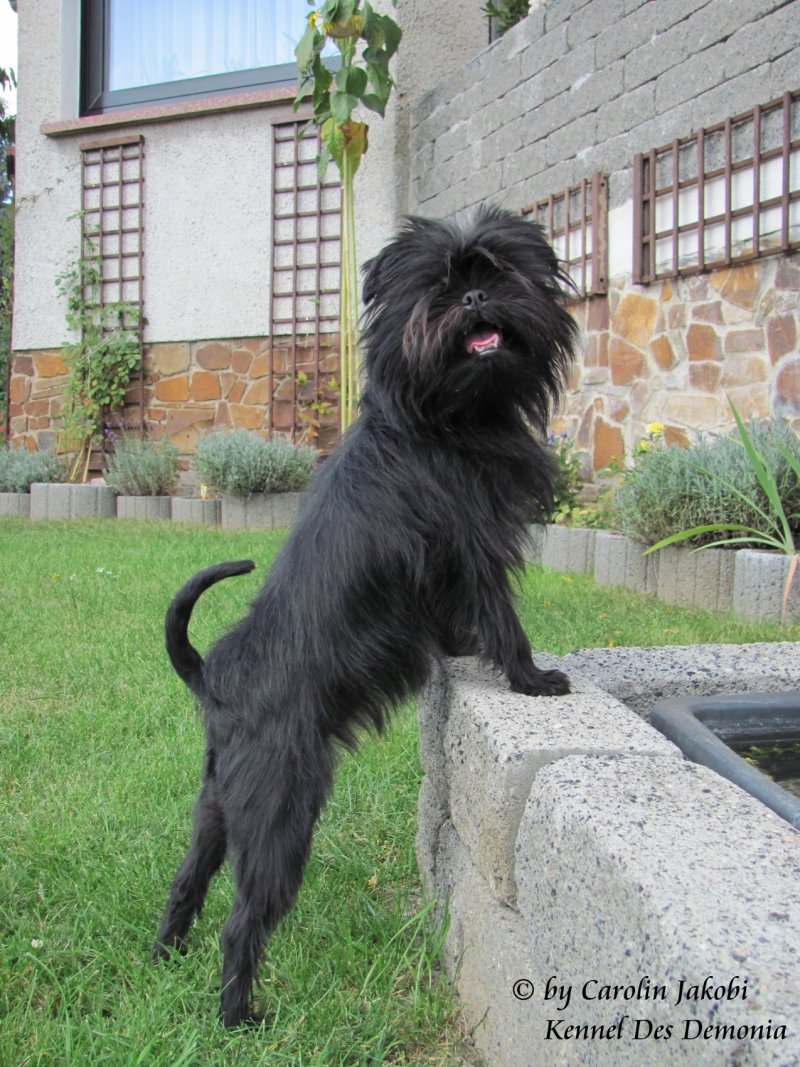
| Country of origin: | Germany |
| Registries: | AKC, UKC, CKC |
| Breed Group: | Toy Group |
| Occupation: | Ratter, companion |
| Size: | 3–3.5kg (7–8lb), 25–30cm (10–12in) |
| Longevity: | 14 to 16 years |
| Exercise: | Active dog |
| Training: | Easy; hard to focus |
| Grooming: | Hand-stripping or professional groomer |
| Colors: | Usually black or grey, but also silver, red, black and tan, or beige, sometimes with white patches |
The comical look of this breed is best summed up by its other name: Monkey Dog. Despite its impish features, this breed was first developed in Germany as an adept ratter, and it will still hunt vermin and track small game. The origins of the Affenpinscher are obscure, but its anatomy suggests that it was developed from crossing small, local pinschers with pug-like dogs from Asia. It is probably the parent of the Belgian griffons. As a companion breed, the Affenpinscher is feisty and stubborn, with a tendency to snap. However, it adapts well to urban living and, unlike most terriers, does not feel the need to challenge other dogs. The bushy, coarse coat doesn’t mat easily. While breathing problems in this short-nosed breed are uncommon, gum disease, caused by closely packed teeth, is more frequent.
History
The Affenpinscher is a small breed of dogs that originated from Germany. Their name is of German origin and roughly translates to “monkey-like”. These toy dogs are speculated to have been around since the 17th century. Although known as one of the most ancient of breeds, the AKC validated the breed in the year 1936.
From the beginning of time, these dogs were utilized to clear barns and homes from rodents. Now these monkey-terrier are solely designated to being loving housepets. Although it might be important to note that the Affenpinscher have been reduced to a rare breed.
Affenpinschers have only recently received more attention due to a Westminster Kennel Club victory. In February 2013, an Affen pup by the name of Banana Joe took home the “Best in Show” award. This 9-year old, shaggy show dog sparked an interest in many. These furry companions began receiving recognition again.
Personality
These small terrier-like canines are fearless and fun-loving. They are confident and balanced. Although they can be quite stubborn at times, they are playful and curious. Additionally, their ability to make their human sidekicks laugh make them great therapy dogs.
Since they have a loving nature, they are considered great family dogs. On the other hand, they may not be the best with small children and may become aggressive if provoked. They tend to be fine with other animals as well. Consider a “once a ratter, always a ratter” type of mentality and exercise precaution with smaller animals, just in case.
Traits
The Affenpinscher is considered a small toy breed. They average at a weight of about 6.5 to 13 pounds and a height of 9-12 inches tall. Although they are terrier-like in personality, they are part of the pinscher/schnauzer dog classification.
They sport a wire-like coat and appear shaggy. Despite being shaggy, they are neat dogs with low-maintenance grooming. According to the Affen breed standards, the general fur color is black as night. The AKC does recognize other various colors though such as gray, black and tan, and beige. Still, black is preferred.
Handling
Affenpinschers are adaptable and quick learners. They make great house pets despite being stubborn. They do not like to be alone and tend to get bored easily. With these attributes, it may be wearisome to housebreak them. Firm training is very recommended from the start.
Since they get bored easily and have a medium energy, walks are also a must for these wire-haired furballs. This enforces a consistent schedule to aid in the housebreaking process as well.
As mentioned above, this breed of dogs have low-maintenance grooming but not to be mistaken as non-shedding. They have minimal shedding and are in fact hypoallergenic. Daily brushing is still important as to avoid shedding as much as possible.
Health
These pooches have a lifespan averaging of around 11.4 years, with old age being the number one reason for crossing the rainbow bridge. Just like with other small dog breeds, hip dysplasia and uxating patella tends to be a common issue in older age. These issues can be held off or prevented with extra measures, such as installing steps to avoid constant jumping.
External links
- Affenpinscher breed standard at the official American Kennel Club website
- Affenpinscher at the Open Directory Project
- Affenpinscher Club of America
- The Affenpinscher Club UK
- Early History of the Affenpinscher











